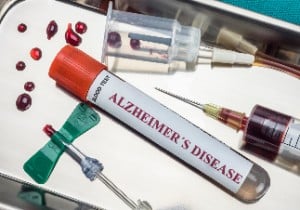Share this
can a blood test for Alzheimer's disease provide clues for a cure?
by Neoteryx Microsampling on Nov 9, 2020 8:00:00 AM
 Alzheimer’s disease, the most common type of dementia, causes cognitive decline, mood and behavior changes, and memory loss. The leading cause of Alzheimer's disease (AD) is the accumulation of the 42-amino-acid-long amyloid beta-peptide, the Aβ1–42 in the brain. Research shows that patients with AD have less Aβ1–42 in their cerebrospinal fluid (CSF) than healthy individuals.
Alzheimer’s disease, the most common type of dementia, causes cognitive decline, mood and behavior changes, and memory loss. The leading cause of Alzheimer's disease (AD) is the accumulation of the 42-amino-acid-long amyloid beta-peptide, the Aβ1–42 in the brain. Research shows that patients with AD have less Aβ1–42 in their cerebrospinal fluid (CSF) than healthy individuals.
Advancements in CSF detection and positron emission tomography (PET) analyses have improved accuracy in diagnostic processes. This enables researchers to detect Alzheimer's earlier. A drawback to the PET process, however, is that it is very involved and costly, and not always accessible to everyone — PET scans are only available in specific medical centers in wealthy countries.
Sampling and screening of cerebrospinal fluid (CSF) seems to be a cheaper diagnostic approach, but the procedure can lead to complications, such as headaches. Also, CSF is not a standard procedure in many clinics around the world.
Alzheimer's Biomarkers in Blood
Researchers have begun using blood testing for Alzheimer studies. Recent advances in detection technologies and serology studies enable scientists to better detect circulating biomarkers (RNAs, proteins, and other molecules) in the blood, leading to more precise and reliable measurements of diseases. Blood tests also enable researchers to screen large numbers of healthy people in an effort to identify those most likely to develop AD.
If successful, blood tests that detect circulating biomarkers of AD can help researchers develop therapeutic medications that are designed to be administered before the onset of AD symptoms. It is hoped that such medications can delay cognitive symptoms by at least five years. Multiple labs worldwide have been looking for new biomarkers for AD. They are developing blood tests that can identify the early signs of Alzheimer’s disease, monitor the disease progression, and differentiate it from similar conditions.
Here are some of the new biomarkers discovered so far:
Biomarker: aβ42 and aβ40: The presence of aβ42 and aβ40 isoforms show a buildup of amyloid plaques in the brain, which triggers a sequence of pathological processes. Lower ratios of aβ42:aβ40 and levels of aβ42 in the cerebrospinal fluid are the best indicators of Alzheimer’s Disease.
Biomarker: Neurofilament Light: A recent study shows patients with Alzheimer’s experience an increase in neurofilament light (Nfl) chain protein in the spinal fluid and the blood 16 years before onset. The study also found the rate of increase in the protein correlated with the shrinking of the brain’s precuneus region, and the patients performed worse in cognitive tests. The protein makes a reliable biomarker to track the progression of the disease non-invasively.
Biomarker: Tau and p-tau: Studies presented at the 2020 Alzheimer’s Association International Conference showed the tau protein p-tau217 is an indication of the presence of Alzheimer’s disease. High levels of tau or the phosphorylated form, p-tau, make a reliable biomarker candidate because it also indicates the presence of damaging neurofibrillary tangles in the brain. According to another Alzheimer’s researcher, Dr. Michael Weiner at the University of California, San Francisco (UCSF), this blood test accurately predicts the presence of the disease in the brain.
Is there a blood test available today that accurately identifies Alzheimer’s disease?
To date, there’s no specific blood test for Alzheimer’s. However, the identification of these biomarker candidates can help researchers get closer to accurately predicting or identifying the presence of the disease in patients through blood collection and blood testing.
Advances in blood collection methods make it easier for researchers to engage a wider group of participants in AD clinical trials. Venous blood draws in a clinic are not necessary as a standard blood collection method. Instead, researchers can use remote sample collection methods that are less invasive and more convenient for participants. Remote blood collection can eliminate the need for clinic visits, thus enabling virtual clinical trials.
The development of remote blood collection tools such as the Mitra® device based on VAMS® technology means that more people – in this case, people who suspect they have a predilection for Alzheimer's disease – can remotely participate in clinical research studies, virtual clinical trials and telemedicine programs. In most cases, they can collect their own blood samples at home and mail them to the designated microsampling lab for analysis.
This is curated content. To learn more about the research behind this news update, please view the original source materials included here:
https://www.the-scientist.com/features/the-hunt-for-a-blood-test-for-alzheimers-disease-66743
https://www.the-scientist.com/news-opinion/protein-changes-detected-in-blood-years-before-alzheimers-onset-65347
https://www.the-scientist.com/infographics/infographic--biomarkers-in-blood-provide-a-window-into-the-brain-66749
https://www.the-scientist.com/news-opinion/experimental-blood-test-could-flag-alzheimers-67779
Looking for a microsampling lab that processes remote specimen samples?

Share this
- Microsampling (206)
- Research, Remote Research (119)
- Venipuncture Alternative (105)
- Clinical Trials, Clinical Research (83)
- Mitra® Device (73)
- Therapeutic Drug Monitoring, TDM (51)
- Dried Blood Spot, DBS (39)
- Biomonitoring, Health, Wellness (30)
- Infectious Disease, Vaccines, COVID-19 (24)
- Blood Microsampling, Serology (23)
- Omics, Multi-Omics (21)
- Decentralized Clinical Trial (DCT) (20)
- Specimen Collection (18)
- Toxicology, Doping, Drug/Alcohol Monitoring, PEth (17)
- Skin Microsampling, Microbiopsy (14)
- hemaPEN® Device (13)
- Preclinical Research, Animal Studies (12)
- Pharmaceuticals, Drug Development (9)
- Harpera Device (7)
- Industry News, Microsampling News (5)
- Antibodies, MAbs (3)
- Company Press Release, Product Press Release (3)
- Environmental Toxins, Exposures (1)
- July 2025 (1)
- May 2025 (1)
- April 2025 (2)
- December 2024 (2)
- November 2024 (1)
- October 2024 (3)
- September 2024 (1)
- June 2024 (1)
- May 2024 (1)
- April 2024 (4)
- March 2024 (1)
- February 2024 (2)
- January 2024 (4)
- December 2023 (3)
- November 2023 (3)
- October 2023 (3)
- September 2023 (3)
- July 2023 (3)
- June 2023 (2)
- April 2023 (2)
- March 2023 (2)
- February 2023 (2)
- January 2023 (3)
- December 2022 (2)
- November 2022 (3)
- October 2022 (4)
- September 2022 (3)
- August 2022 (5)
- July 2022 (2)
- June 2022 (2)
- May 2022 (4)
- April 2022 (3)
- March 2022 (3)
- February 2022 (4)
- January 2022 (5)
- December 2021 (3)
- November 2021 (5)
- October 2021 (3)
- September 2021 (3)
- August 2021 (4)
- July 2021 (4)
- June 2021 (4)
- May 2021 (4)
- April 2021 (3)
- March 2021 (5)
- February 2021 (4)
- January 2021 (4)
- December 2020 (3)
- November 2020 (5)
- October 2020 (4)
- September 2020 (3)
- August 2020 (3)
- July 2020 (6)
- June 2020 (4)
- May 2020 (4)
- April 2020 (3)
- March 2020 (6)
- February 2020 (3)
- January 2020 (4)
- December 2019 (5)
- November 2019 (4)
- October 2019 (2)
- September 2019 (4)
- August 2019 (4)
- July 2019 (3)
- June 2019 (7)
- May 2019 (6)
- April 2019 (5)
- March 2019 (6)
- February 2019 (5)
- January 2019 (8)
- December 2018 (3)
- November 2018 (4)
- October 2018 (7)
- September 2018 (6)
- August 2018 (5)
- July 2018 (8)
- June 2018 (6)
- May 2018 (5)
- April 2018 (6)
- March 2018 (4)
- February 2018 (6)
- January 2018 (4)
- December 2017 (2)
- November 2017 (3)
- October 2017 (2)
- September 2017 (4)
- August 2017 (2)
- July 2017 (4)
- June 2017 (5)
- May 2017 (6)
- April 2017 (6)
- March 2017 (5)
- February 2017 (4)
- January 2017 (1)
- July 2016 (3)
- May 2016 (1)
- April 2016 (2)


No Comments Yet
Let us know what you think